Cannabis has been used for millennia in diverse cultures for its therapeutic properties. Recently, the rise in medicinal cannabis usage has been fueled by emerging scientific research and shifting societal perceptions. Join us on an exploration of how this ancient plant is shaping modern medicine.
The Historical Roots
The medicinal use of cannabis dates back to ancient civilizations. Records from China and Egypt point to cannabis being used for pain relief and inflammation. Fast forward to modern times, the re-emergence of cannabis as a medical aid is sparking interest both in scientific and cultural communities.
Modern Medicinal Applications
Today, cannabis is employed in a variety of medical contexts, from mitigating chronic pain and anxiety to easing the symptoms of chemotherapy. Its application in managing conditions like epilepsy, multiple sclerosis, and PTSD is supported by a growing body of scientific research.
- Chronic Pain: Cannabis cannabinoids interact with bodily receptors to reduce pain.
- Anxiety and Depression: Certain strains can alleviate anxiety, fostering a sense of calm.
- Epilepsy: CBD-rich strains have proven effective in reducing seizure frequency.
Case Study: Colorado Innovation
In the heart of Colorado, cannabis cultivator John “Magic” Greenleaf has been leading the charge in breeding medicinal strains. His “Magic Kush” is renowned for its powerful effects, offering significant relief for pain and promoting restful sleep.
By pioneering sustainable cultivation techniques, John reduces water and energy usage, aligning his practices with ecological mindfulness. His efforts ensure that cannabis remains an accessible and responsible choice for medicinal use.
The Future of Medicinal Cannabis
The expansion of cannabis usage in medicine promises enhanced treatments and novel applications. As research deepens our understanding, new paradigms in treating mental and physical ailments through cannabis will likely emerge, presenting a new dawn in medical science.


Leave a Reply